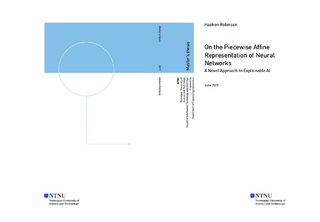On the Piecewise Affine Representation of Neural Networks
Master thesis
Permanent lenke
http://hdl.handle.net/11250/2625667Utgivelsesdato
2019Metadata
Vis full innførselSamlinger
Sammendrag
Det kan vises at nevrale nett kan uttrykkes som stykkevise affine (PWA) funksjoner. Men, forskning har fokusert på å telle de lineære regionene, fremfor å finne den eksplitte PWA formen. Denne oppgaven fremfører en algoritme som finner PWA formen til nevrale nett, og bruker dette til å utforske applikasjoner innen modellering og reguleringsteknikk. In exchange for large quantities of data and processing power, learning algorithms have yielded models thatprovide state of the art predication capabilities in many fields. However, the lack of strong guarantees ontheir behaviour have raised concerns over their use in safety-critical applications.It can be shown that neural networks with piecewise affine (PWA) activation functions are themselves PWA,with their domains consisting of a vast number of linear regions. Research on this topic has focused oncounting the number of linear regions, rather than obtaining the explicit PWA representation. This thesispresents a novel algorithm that can compute the PWA form of fully connected neural networks with ReLUactivations. Several case studies regarding the usefulness of this representation in terms of modeling andcontrol are undertaken. Nominal stability results for a simple dynamical system based on a small neuralnetwork are obtained via the Lyapunov method for PWA systems, and suggestions for extending the approachto neural networks of arbitrary size are outlined. Moreover, the practicality of using MPC and data-drivenmethods to control neural networks is investigated.
